| Ecology
and Sustainable Development |
index of MD-IAE| |
 |
by
Yevgeny Shirokov Chairman of Belarusian Division of International Academy of Ecology |
| Building
with Straw Bales in Belarus |
| Start:
1996... |
| In
Belarus, a coalition of local and international NGO's is proving that
straw-bale houses are to be taken seriously. Environmentally friendly
and energy efficient, these homes are a sound way to provide affordable
housing. In Belarus there are plans to use this tech-nology to construct
homes for children forced out of their homes due to the Chernobyl disaster,
neighboring Ukraine is considering the use of straw-bale houses in resettlement
communities for Crimean Tartars. The Belarusian economy is in a state
of crisis and cheap and well-insulated houses are much needed. |
| In
August 1996, three organizations, the American organization
Solar Energy International, the Belarusian Division of the International
Academy of Ecology and German-Belarusian NGO "Houses for Chernobyl
settlers" conducted a straw-bale house-raising seminar in Zanaroch,
an experimental environmental village. The 13 seminar participants included
representatives of NGO's and government construction companies from Ukraine,
Russia and Uzbekistan. Zanaroch was chosen because BD IAE was a partner
of German-Belarusian organization called "A Home in Place of Chernobyl",
has been working there for the last six years to build an en-vironmental
village for Chernobyl refugees using clay-straw technology. The village
already includes 18 buildings and is becoming a testing ground for environmentally
sound technologies for sustainable development. More than 70 percent of the radiation that escaped from the Chernobyl Atomic Power Station fell on the territory of Belarus-an amount equivalent to 90 of the atomic bombs dropped on Hiroshima. People who are still being displaced from the contaminated area need environmentally safe, energy efficient, inexpensive housing. Straw-bale technology meets these requirements. |
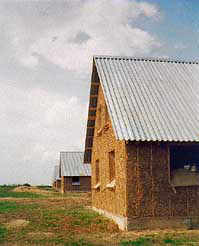 |
Straw-clay houses in Zanaroch, 1996. |
| The project
itself did not have an easy beginning. The initial budget was several
times too low. Fortunately, an agreement was reached with German partners
to provide the basic construction materials at no cost, and the project
was saved. The weather was the second serious obstacle. The gram crop in Belarus in the summer of 1996 was running three weeks late, and the project had to make use of the previous year's straw (it was rye straw, 90% of straw in Belarus is rye). What could have been a disaster ended up proving the feasibility of forming bales from piles of old straw, which are common in the FSU. The bales were prepared in two days, and the home it-self was built in just a week. The detail work on the home had to be done after the seminar, in September, by BD IAE stuff. |
 |
First
in FSU finished SB house (left), finished straw-clay house (right), German
bunker WWI (ahead). Zanaroch, September 1996. |
| Attempts
to interest government agencies in this technology proved
unsuccessful until an appeal was made directly to the president of Belarus.
Following an order from the presidential administration, representatives
of the Ministry of Construction and Architecture visited the site in October.
What they saw in Zanaroch significantly changed their ideas about existing
and proposed construction technologies. As a result, a National SB program
is being developed for the construction of 12 demonstration straw-bale
and straw-clay houses in Belarus, two in each region of the country. Further
government support came in January 1997, when the city of Minsk granted
land to the International Academy of Ecology to build a demonstration
zero-energy straw-bale house, featuring a domestically produced solar
water heater on the roof (only 10 $/m2) and permaculture landscaping with
water reuse and efficiency systems. In 1998 the Ministry paid for the
Belarusian SB Code. But till now BD IAE has problems with SB housing in
towns: professional building firms are not happy -- SB houses are 3-4
times cheaper in Belarus than conventional brick houses, and they can
loose the market... |
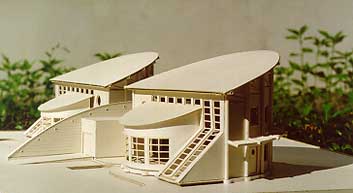 |
Zero-energy SB house. Model. Minsk, 1998. |
| Anyway,
more than 100 small building firms and NGO's in Belarus and more than
50 in Russia and Ukraine have requested copies of the Russian version
of Build It With Bales, an instructional book by S.O. MacDonald and Matts
Myhrman that has been translated as a part of the project. Distribution
of the book is ongoing at conferences and gatherings, and we hope to expand
these distribution efforts into other NIS countries, using workshop participants
to help promote the book. Visitors, both private citizens and representatives
of professional construction firms, continue to travel to Zanaroch to
tour the village and our straw-bale structure. Having made successful use of the straw-bale tech-nology in Belarus, we now plan to outfit straw-bale houses with our inexpensive solar collectors. Calculations show that these types of homes could have zero energy requirements. The International Academy of Ecology has published a small booklet comparing the economics of a straw-bale home with a typical home of the same size built with conventional materials. This book is an invaluable part of persuading government officials and private citizens of the benefits of straw-bale construction. |
| 1998:
new SB houses, technologies, researches... |
| Some Belarusian
building institutes are involved now in the National SB program with the
help of Deputy Minister Anatoly Nichcasov. He is a real architect and
a fan of SB housing. The Ministry of Construction and Architecture pays
for some SB projects and investigations, invites the BD IAE (NGO) to participate
in National Habitat Center and State Commission on Sustainable Development
of Human Settlements. Some results of cooperation between the Ministry,
BD IAE and local firms/ building institutes in the National program are
below. |
| New
constructions and technologies: summer and winter. |
| On the
photo you can see 2 equal size SB houses (1997) in Michedovichi, Gomel
region: left -- built in summer, right -- in winter (-25 C, it's little
bit masochistic way, but usual). The design of the walls is different, (see below) but it shows Belarusian mentality: walls must be "solid". |
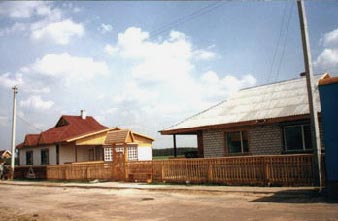 |
SB houses in Mihedovichi (1997): "summer" technology (left), "winter" technology (right). |
| Plan of
a countryside SB house is simple. Houses are heated by a massive bricks/clay
wood stove in the center (the Russian type -- for cooking & heating, very
healthy). Difference in design of "Mihedovichi" SB walls: "winter" (left), "summer" (right). 1 -- outside lay (half-brick -- winter, 2 lays of cement plaster on grid -- summer), 2 -- SB "slim" -- summer, "tower" -- winter, 3 -- clay, lime, or cement plaster, 4 -- light bricks wall (300 kg/m3), all units -- mm. |
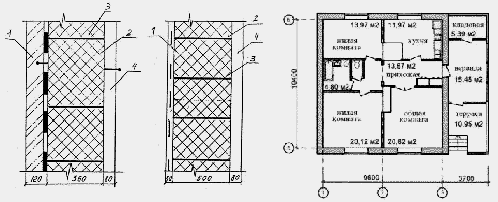 |
| In November
1998 we have finished an official test of SB house in Michedovichi (family
lives here since Jan.1997, flood occured in summer 1998). There were no
problems with moisture in walls, R-value being 4 times higher than officially
recommended (national code in metric system recommends R=2.5, test values
of SB walls were R=7 for "winter" and R=10 for "summer", respectively).
Health of people living in SB house (including children) was improved. SB house inhabitance required 4 times less fuel than in conventional brick houses. We have calculated the amount of energy necessary for both an SB building and a brick house in our climate. The relation was 1:150, price relation -- 1:4. That is why SB houses grow up in Belarus like mushrooms: 1996 -- 1, 1997 -- 3, 1998 -- near 40... Since 1998 each SB house has 5 m2 plastic solar collector (only 30$, 5 years guarantee, designed by BD IAE) for water heating (April-September). |
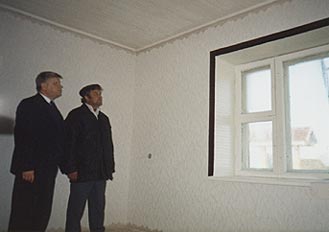 |
Inside the SB house in Mihedovichi. |
| Information
on SB activities of the BD IAE |
| Of course,
this success was impossible without information activities. First was
translation and edition of "Build it with Bales" in Belarus and "New vision
of building materials. Houses of straw" written by Bogdan Kolitenko (Ukraine)
in 1996. In 1997-1998 we have published near 30 articles in public and special newspapers, magazines, books. "Radio of Russia" (near 80 millions people from FSU can listen to) prepared a 30 minutes interview about the SB technology and activities in Belarus with the author of this report. As a result we have got near 5000 letters only from Russia -- people want to obtain the SB technology. They don't care about sustainability, but low price and good heat insulation -- this is a reason. |
 |
Simple
glass-plastic solar collector on a straw-clay house. |
 |
Amount of SB houses in Belarus, already built and in prospect up to 2000. |
| We have
also prepared a special issue of the magazine "Architecture and Construction
of Russia" #5, 1998 (5000 copies) including the SB technology and the
activities in Belarus. Some TV programs gave us time to represent information
about the SB activities. This year we will prepare a special Program for
builders schools and universities. Now we start collaborating with our
friends in Russia, Ukraine, Moldova and other East and some West Europe
countries. |
 |
Zero-energy SB house with Permaculture system (2 houses will be built in Minsk and Petrikov in 1999. |
| Сonclusion |
| Economic
and financial crisis in Belarus as well as the problem of Chernobyl settlers
prepare conditions for SB business activities in our country. So, thanks
to crisis! We really go to sustainable development, because the situation
forces us to use the SB technology, permaculture, etc. |